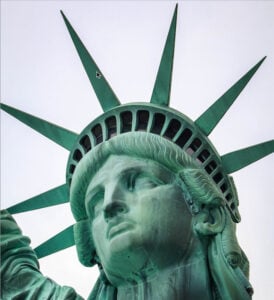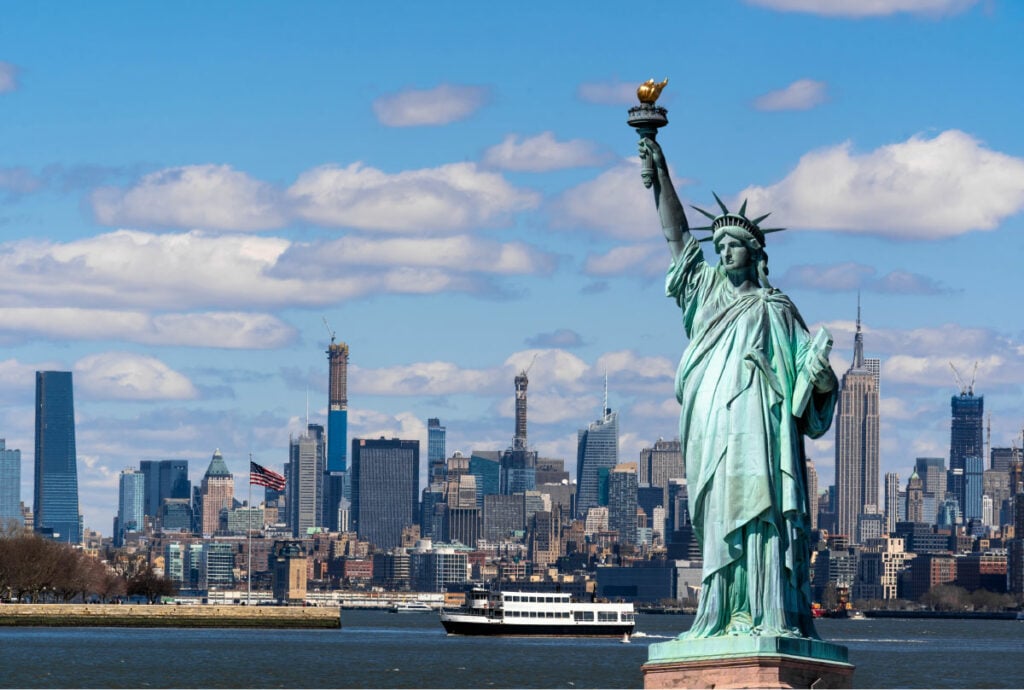IIf you’re planning a trip to New York City, you’ll likely spend some time viewing one of the Big Apple’s most famous sights: the Statue of Liberty. Most people know that the statue was a gift from France that has served as a beacon of freedom to arriving immigrants for many years.
But there’s also a good bit of information about the statue that you may not have heard. By perusing these Statue of Liberty facts before you go, you’ll deepen your appreciation of this masterful work of art that stands as an American icon.
1 She Has Several Names
Most people know her as the Statue of Liberty or Lady Liberty. But did you know that her official name is Liberty Enlightening the World? Designed by French sculptor Frederic Bartholdi, the statue was dedicated in 1886, and in 1924 she was designated as a National Monument. Whatever you prefer to call her, the statue remains a national treasure.
2 She’s Had Work Done
Yes, Lady Liberty has had a few nips and tucks. In the mid-1980s, she underwent a multimillion-dollar renovation. As part of the project, she received a new torch to replace the old one that was corroded beyond mending. On July 5, 1986, a centennial celebration marked the official return of Lady Liberty.

3 The Eiffel Tower’s Designer Helped Build Her
To create the “skeleton” on which he would hammer large copper sheets to serve as “skin,” sculptor Bartholdi called on Alexandre-Gustave Eiffel, designer of the iconic Eiffel Tower. Eiffel created the framework from iron pylon and steel which acted as an internal support system.
Unlike traditional sculptures, where a rigid frame might lead to cracks or structural failure, Eiffel’s pioneering technique allowed the statue’s copper skin to move independently in response to wind, temperature fluctuations, and other environmental factors. This design, known as structural flexibility, prevents excessive stress on the statue, ensuring its durability over time.
Additionally, Eiffel incorporated a central support column, connected to the outer shell by a series of iron armatures, allowing the statue to remain stable while subtly shifting with the wind. This innovative engineering is the same principle that keeps the Eiffel Tower standing strong against the forces of nature.
Thanks to Eiffel’s visionary design, the Statue of Liberty has endured for over a century, withstanding hurricanes, extreme temperatures, and the test of time—all while continuing to stand as a powerful symbol of freedom and democracy.
4 The Weather was Terrible on Her Inauguration Day
On Oct. 28, 1886, a parade marked the statue’s official installation in New York. The weather that day was so bad that a planned fireworks display was postponed until Nov. 1; however, heavy rains weren’t enough to stop the proceedings, as President Grover Cleveland accepted on behalf of the nation “this grand and imposing work of art.”
5 The Statue Represents A Roman Goddess:
Many people visit the Statue of Liberty without knowing that it represents a Roman goddess. The goddess in question is Libertas, the personification of liberty. She is often depicted holding a torch and a tabula ansata, which is a tablet inscribed with the date of the American Declaration of Independence. The statue was a gift from the people of France to the people of America, and French sculptor Frédéric Auguste Bartholdi designed it.
Libertas inspired Bartholdi after witnessing how the people of France venerated her during the French Revolution. When he later visited America, he saw that the same kind of reverence was given to Liberty. As a result, he decided to create a monument that would symbolize the shared values of liberty and democracy. The Statue of Liberty is one of the most recognizable monuments in the world, and it continues to stand as a beacon of hope for all who believe in the power of freedom.

6 The Crown’s Spikes Represents The Oceans And Continents:
The Statue of Liberty’s crown is one of its most recognizable features. But did you know that each of the seven spikes represents one of the world’s oceans and continents? The seven spikes on the Statue of Liberty’s crown represent the seven oceans and continents of the world. Bartholdi chose this design to symbolize the universal concept of liberty. The statue’s torch also represents enlightenment, which is another key principle of liberty. The statue was originally intended to symbolize the idea of liberty and freedom for all people, regardless of where they lived. This message is still relevant today and is one of the many reasons why the Statue of Liberty is such an iconic symbol. If you’re planning a trip to see this American icon, be sure to add these interesting facts to your knowledge base!
7 The Statue Of Liberty Is Located On Liberty Island:
Most people know that the Statue of Liberty is located on an island in the harbor of New York City. However, many are surprised to learn that the island was actually named after the statue. Before it was called Liberty Island, it was known as Bedloe’s Island. The name change came about in retaliation to British attacks during the American Revolution. A British warship had shelled the island, causing extensive damage to its fortifications. In response, Congress renamed the island in honor of the symbol of American liberty.

8 You Can Take A Ferry To The Statue Of Liberty:
If you’re planning a trip to see the Statue of Liberty, you can take a ferry from either Battery Park in New York City or Liberty State Park in New Jersey. The ferry ride takes about 15 minutes and provides some great views of the Statue of Liberty and Ellis Island. Once you’re on Liberty Island, you can explore the grounds, visit the pedestal, and even take a tour of the Statue of Liberty Museum. This is one of the most popular tourist activities on the island, and it’s a great way to get an up-close look at this American icon. Remember – Statue City Cruises is the ONLY AUTHORIZED OFFICIAL PROVIDER of tickets to the Statue of Liberty National Monument and Ellis Island. Please be aware that street vendors do NOT sell genuine Statue of Liberty tickets. Avoid street sellers.
Meet The Lady In Person
Now that you’re familiar with these Statue of Liberty facts, it’s time to plan your visit. By taking a ferry to the Statue of Liberty, you can see for yourself the craftsmanship and symbolism that make Lady Liberty a timeless emblem of democracy.
FAQs – Statue of Liberty Facts to Know Before You Go
Where is the Statue of Liberty located?
The Statue of Liberty is on Liberty Island in New York Harbor. It is accessible only by ferry from Battery Park (New York City) and Liberty State Park (New Jersey).
How do I get to the Statue of Liberty?
You must take a ferry operated by Statue City Cruises from either Battery Park (NY) or Liberty State Park (NJ). Advance ticket reservations are recommended.
Can I go inside the Statue of Liberty?
Yes! Visitors can enter the pedestal (which includes a museum) and crown, but crown access requires special tickets booked in advance due to limited availability.
How tall is the Statue of Liberty?
The statue stands 305 feet (93 meters) from the base to the tip of the torch.
What does the Statue of Liberty symbolize?
It represents freedom, democracy, and the end of oppression. The torch signifies enlightenment, and the broken shackles at her feet symbolize liberty from tyranny.
What is written on the tablet she holds?
The tablet is inscribed with “JULY IV MDCCLXXVI”, which stands for July 4, 1776, the date of American independence.
Who designed the Statue of Liberty?
French sculptor Frédéric Auguste Bartholdi designed it, and engineer Gustave Eiffel (who built the Eiffel Tower) designed its metal framework.
Is there an entrance fee?
There is no fee to enter Liberty Island, but ferry tickets must be purchased. Additional fees apply for pedestal and crown access.
Can I visit Ellis Island on the same trip?
Yes! Ferry tickets often include a stop at Ellis Island, home to the Ellis Island National Museum of Immigration.
What are the best times to visit?
Arriving early (first ferry of the day) helps avoid crowds. Spring and fall offer pleasant weather with fewer visitors than summer.
Original Post Date: July 1, 2019

 Discover Experiences Near Me
Discover Experiences Near Me
